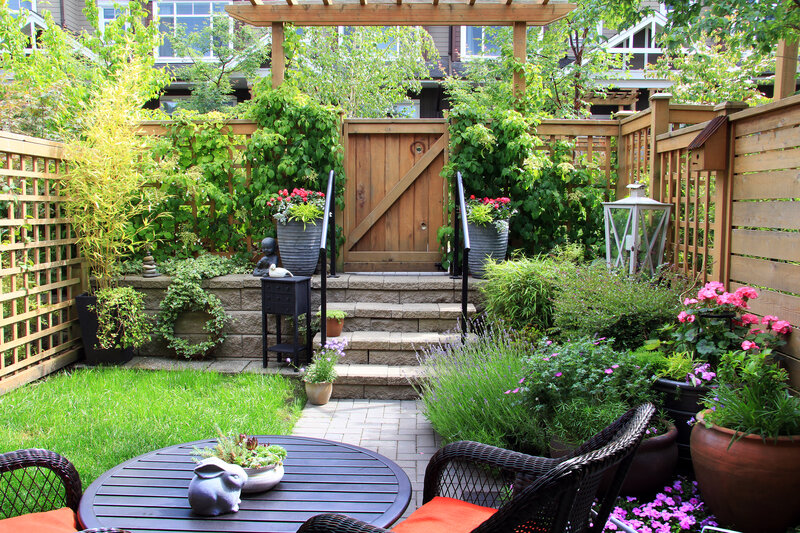CA Contractors #344056

For some, professional landscape support is essential. For others, their own love of gardening or budget constraints lend them to a DIY landscaping approach. If you fall into the latter category, we have seven DIY small garden landscaping tips to get you started.
If you wind up needs a little support, feel free to schedule a consultation with us here at Bay Area Landscaping. We’re happy to provide competitively-priced consultations and design tips to give your landscape or gardening spaces the boost they need to thrive.
There is virtually no such thing as a “no maintenance” landscape. All living things need some level of attention, care, and maintenance. That said, on a scale of 1 to 20, landscapes range from low-maintenance (1, 2, or 3) to very high-maintenance (8, 9, or 10). As a DIY landscaper, it’s time to establish where you fall on a 1 to 10 maintenance scale.
Knowing how much time, energy, and equipment you’re willing to invest into your landscape, the better you can create a plan. For example, if you want a low-maintenance landscape, you’ll focus more on hardscape features and very drought- or pruning-minimum plants. On the other hand, if you love to putter, prune, and nurture on a daily basis, you can pursue a landscape design that entails higher-maintenance features, like a cutting garden.
Professional landscapers have many tricks up their sleeves to make a small yard space seem bigger and more spacious than it is. Examples include things such as:
If your space is small, read How to Make a Small Backyard Seem Larger.
Ask local nurseries or landscape supply stores if they perform soil samples. The health, vibrancy, and resiliency of your landscape are 100% related to the health of the soil. However, all dirt is not created equal.
Soil samples provide answers you can work with. You’ll learn whether your soil holds water or lets it drain right through. It will share whether it’s nutrient-rich or depleted. The results let you know what soil amendments are necessary to grow your preferred plants.
You may have nutrient-rich, well-draining soil. Sounds great, right? But, what if you want to create a shade garden using plants that are more water-happy? You’ll need to amend it with products that improve water retention.
On the flip side, if you have a sun-exposed area of the yard where you plan to have a succulent garden (drought-tolerant), but you find out the soil is heavy with clay and doesn’t drain, you’ll need to remove some of it and amend it with amendments that improve drainage.
If you’re gung-ho to begin a DIY landscape, we highly recommend starting your compost pile.
High-quality compost can make your gardening world go ‘round. You can spend lots of money at your local garden supply store buying bags of compost or having them deliver cubic square feet of compost each season to fertilize and supplement your garden soil. OR, you can make your own.
Compost is made from a combination of kitchen food scraps, the debris created by pruning, weeding, mowing, or the fallout from a windy storm. You can add broken-down cardboard boxes, your neighbors’ kitchen scraps, and all kinds of biodegradable/compostable materials to keep them out of the landfill. When they’re layered, occasionally mixed up, and retain optimal moisture levels (you can water your compost when it’s hot or dry).
Read Backyard Composting for the First-Timer to learn more. As a DIYer, we can tell you you’re going to love making compost. For many of us, it is now an obsession.
If you don’t have a tree in your yard yet, it’s time to learn more about the potentials and plant one expertly selected tree. You do not want a tree that takes over and uses all of the space, nor do you want one that could compromise the architecture of your home.
Examples include:
Read GH’s 9 Trees for Small Yards for more examples.
You may find you want to change things around from year to year in a small yard. By building raised beds and planters, you can move them with a furniture dolly and move them elsewhere. It’s a way to “rearrange” your landscape the same way an interior decorator can expertly rearrange a room to suit the season or your changing tastes. Raised beds also make it easier to amend the soil and prevent gopher infiltration.
Visit Raised Bed Garden Styles for inspiration.
Bonus Tip: Continue Gleaning Tips From the Pros
Professional landscapers post so much information online. You can learn a tremendous amount about what to do (and what not to do) by reading professional online advice from landscape professionals.
To start, visit our post 10 Tips for Great Garden Landscape Design and 9 Factors to Consider When Creating Landscape Design Plans.
If you find you need extra assistance or would like professional feedback (or a stamp of approval) about your DIY small garden landscaping ideas, contact us online. You can also give us a call at (510) 944-0898.